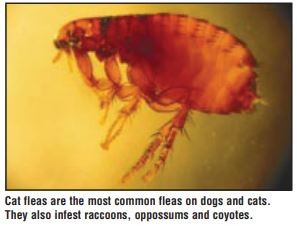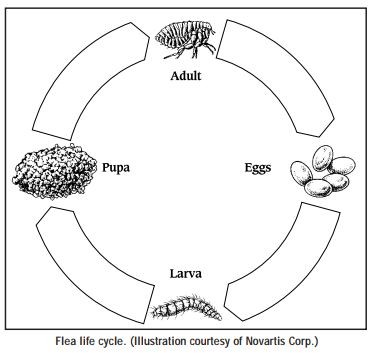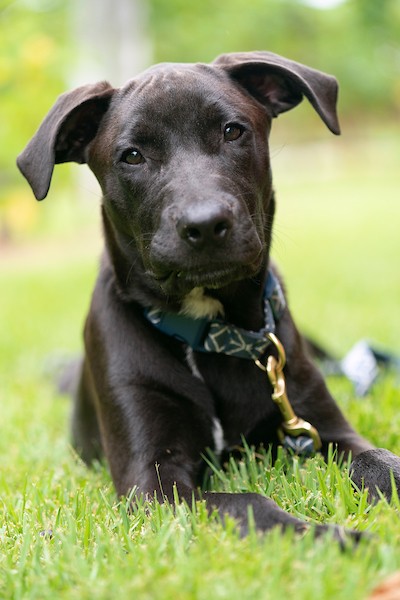Fleas are a common nuisance for pet owners, and understanding their survival capabilities is crucial for effective pest management. These tiny, wingless insects are notorious for their bites and ability to cause discomfort to both animals and humans. In the United States, pet owners spend billions annually on flea control, highlighting the significant impact of these pests. In regions like Texas, the cat flea (Ctenocephalides felis) is the primary culprit, infesting cats, dogs, and various wildlife. While other flea species exist, such as dog fleas, human fleas, and rat fleas, they are less prevalent in homes and on pets. Fortunately, with numerous effective treatments available, flea infestations can be managed.
Identifying Fleas: What to Look For
Adult cat fleas are small, typically measuring about 1/8 inch in length (1 to 3 mm). Their bodies are brownish-black, flattened in appearance, and they lack wings. A key feature is their backward-pointing bristles, which aid in movement through the fur or feathers of their hosts and make them difficult to dislodge through grooming. Their six legs, especially the hind pair, are long and adapted for jumping, enabling them to move efficiently between hosts.
Flea larvae, in contrast, are legless and smaller, measuring less than 1/4 inch long (6 mm). They are dirty white in color and are most commonly found in infested pet bedding, where they have access to the necessary nutrients for development.
Flea Survival: Life Cycle and Dependence on Hosts
Fleas undergo a complete life cycle with four stages: egg, larva, pupa, and adult. Adult fleas are agile jumpers but generally do not travel far without a host. They prefer to wait for a host to pass by and then jump onto it. Once on an animal, they typically remain until physically removed or groomed off. The lifespan of adult fleas without a host is limited, generally ranging from a few days up to two weeks. On pets, their survival can vary; they tend to live around 8 days on short-haired cats and dogs but may survive longer on animals with longer fur, which provides better shelter and humidity.
Understanding the Four Life Cycle Stages and Survival Implications
The flea life cycle is critical to understanding their survival and control.
Egg Stage: Female fleas begin laying eggs within 2 days of their first blood meal. Remarkably, they can lay an average of 27 eggs per day, consuming up to 15 times their body weight in blood daily to sustain this reproductive output. A significant portion of this blood is excreted as partially digested feces, known as flea dirt, which is a fine, reddish-black dust commonly observed in pet fur and bedding.
Larva Stage: Flea larvae are dependent on adult flea excrement (flea dirt) as a primary food source. This is crucial for their survival. While they may also consume other organic matter like food particles, dead skin, or feathers, flea dirt is essential. Larval development typically lasts from 5 to 11 days under favorable conditions. Outdoor survival for flea larvae is poor in hot, sunny lawns. Humidity levels below 50 percent or soil temperatures exceeding 95 degrees F are lethal to them. They thrive in moist, shaded areas, particularly near pet resting spots. Indoors, larvae are commonly found under furniture and within pet bedding, seeking dark and humid microclimates.
Pupa Stage: The pupa stage is a transitional phase between larva and adult. The larva spins a cocoon to pupate within, and after one to two weeks, an adult flea emerges. However, adult fleas can remain in their cocoons for extended periods, up to 5 months, in a dormant state. This is a key factor in flea survival even without a host present in the immediate environment. The pupae are stimulated to emerge by physical cues such as vibrations, pressure, heat, and carbon dioxide, signaling the presence of a potential host. This explains why vacant homes can suddenly seem to “come alive” with fleas when new occupants move in, as the dormant pupae are triggered to emerge.
Adult Stage: Once emerged, adult fleas are actively seeking a blood meal. Their survival time without a host is limited to a few days to two weeks under normal household conditions. However, this timeframe can be influenced by environmental factors such as temperature and humidity. In cooler, more humid environments, they might survive slightly longer, but their primary drive is to find a host for feeding and reproduction.
Alt text: Close-up photograph of several adult cat fleas, showcasing their small size and brownish-black color, common parasites on domestic animals.
Health Implications of Fleas for Pets and Humans
Fleas are more than just a nuisance; they pose health risks to both animals and humans. For pets, heavy flea infestations cause constant scratching, leading to skin irritation, roughened coats, and in some cases, nervous behavior. A significant concern is flea allergy dermatitis (FAD), where even a few flea bites can cause intense itching and scratching in allergic animals.
Cat fleas do not typically live on humans but will bite people, especially when handling infested pets. Flea bites on humans result in small, red, itchy bumps, often on the ankles and lower legs. Individuals with flea bite allergies can experience hives, rashes, or generalized itching, with reactions typically appearing 12 to 24 hours after a bite and potentially lasting for a week or more.
Fleas that have fed on rodents can also transmit diseases like plague and murine typhus. Therefore, it is advisable to avoid close contact with wild rodents such as squirrels, rats, and prairie dogs to minimize the risk of disease transmission through their fleas. It’s important to note that cat fleas, while bothersome, are not known to carry plague.
Effective Flea Control Strategies
A comprehensive flea control strategy involves both sanitation practices and targeted treatments for pets and their environment. Eliminating fleas from a home requires consistent effort and may take time, particularly with established infestations.
Sanitation: Your First Line of Defense
Regular sanitation is key to disrupting the flea life cycle and reducing flea populations.
Regularly change pet bedding: Washing pet bedding frequently helps remove flea eggs, larvae, and pupae that accumulate there.
Thorough vacuuming: Vacuuming is a powerful tool, capable of removing up to 30 percent of flea larvae and 60 percent of flea eggs from carpets, along with flea dirt, the larvae’s primary food source. Focus vacuuming efforts under furniture, cushions, chairs, beds, along walls, and in all areas where pets spend time. Critically, vacuum cleaner bags should be discarded at least weekly, as fleas can continue to develop inside and re-infest the home.
Alt text: Diagram illustrating the four stages of the flea life cycle: egg, larva, pupa in a cocoon, and adult flea, emphasizing the cyclical nature of flea infestations.
Treating Pets Directly
Treating pets directly is essential to eliminate adult fleas and prevent further egg laying.
Flea Combs and Baths: Starting with a flea comb and a bath is a gentle yet effective approach. Soap acts as a mild insecticide and helps control light infestations. Flea combs physically remove adult fleas from pet fur, particularly effective when used around the face, neck, and tail base. Dipping the comb in soapy water or alcohol solution after each pass kills the removed fleas.
Insect Growth Regulators (IGRs): IGRs are a safe preventive option. They disrupt the development of flea eggs and larvae, preventing adult fleas from reproducing, eggs from hatching, and larvae from maturing. However, IGRs primarily target eggs and larvae and are often combined with adulticides for faster control. IGRs are available in various forms, including sprays, spot-ons, pills, and food additives. Lufenuron (Program® and Sentinel®), available through veterinarians, is an internal IGR, while methoprene (Precor®, vIGRen®) and pyriproxyfen are topical IGRs found in dips, sprays, spot-ons, and flea collars. IGR treatments typically require 4 to 6 weeks for noticeable control.
Adulticides for Severe Infestations: For heavy infestations, faster-acting adulticides are necessary. Products containing imidacloprid (Advantage™) or fipronil (Frontline™) are effective at killing adult fleas with low toxicity to mammals. Advantage™ provides about a month of protection, while Frontline™ offers up to 3 months of flea control and also kills ticks for up to a month. These are available from veterinarians as sprays and spot-on treatments.
Spot-on Treatments: Spot-on treatments are convenient and effective for adult flea control. Applied to specific spots on the pet’s back, the pesticide spreads through the fur via natural oils. Always follow label instructions carefully, and ensure products are appropriate for the pet’s species and age. Dog products should not be used on cats unless specifically labeled for such use.
Botanical Insecticides: Plant-based insecticides like pyrethrum (pyrethrins) and citrus oil extracts (limonene and linalool) can kill both adult and larval fleas and are generally low in toxicity. However, use them cautiously, as some pets, especially cats, can be sensitive to botanicals, particularly citrus oil products. Claims about garlic, brewer’s yeast, cedar bedding, and herbal sachets for flea control lack scientific support. While fresh cedar chips contain flea-toxic volatile oils, the effect is short-lived, and brewer’s yeast has been proven ineffective.
Alt text: A healthy black Labrador dog resting comfortably in green grass, representing a pet free from flea infestation due to effective preventative care.
Treating Your Home Environment
Treating the pet’s living environment is as important as treating the pet itself to eliminate immature fleas and prevent re-infestation.
Citrus Sprays: Low-toxicity citrus sprays containing limonene or linalool are suitable for indoor use on rugs, carpets, and pet bedding. They kill fleas on contact but offer limited residual protection.
Boron-Based Products: Boron-based products like disodium octaborate tetrahydrate can be applied to carpets indoors. They target immature fleas by contaminating their food source (flea dirt) and have low dermal toxicity. Borates are best used as shampoos to avoid dust and abrasion concerns.
Insect Growth Regulators (IGRs) for Indoor Use: Methoprene and pyriproxyfen are effective IGRs for indoor use. While methoprene degrades in sunlight, it works well indoors. Pyriproxyfen (Archer™ and Nylar™), available to pest control professionals, can be used both indoors and outdoors to control both immature and adult fleas. Focus treatment on pet resting areas and nearby furniture indoors, and shaded outdoor pet areas. Sunny, well-maintained lawns are less likely to harbor fleas.
Follow-up Treatments: Because flea pupae are resistant to many insecticides, a follow-up treatment is usually needed 7 to 10 days after the initial application to address newly emerged adults. Short-residual insecticides like pyrethrins may require two to three follow-up sprays at 5- to 10-day intervals.
Flea Infestations Without Pets
Flea infestations can occur even in the absence of pets. Wildlife such as bats, roof rats, squirrels, raccoons, and feral cats and dogs can nest in buildings and introduce fleas. In such cases, a professional pest control company can manage the flea infestation and seal entry points for wildlife.
Biological and Mechanical Flea Controls
Biological Controls: Natural predators like fire ants and predatory insects consume flea larvae but do not provide complete control. Predatory nematodes are microscopic worms sold for outdoor flea control, showing some effectiveness in sandy soils when the area is irrigated before and after application to aid nematode survival and movement.
Flea Traps: Flea traps, often using a blinking green light to mimic a host’s shadow and a sticky card to trap fleas, can be a useful supplementary tool, especially near pet beds. However, traps alone are unlikely to resolve a flea problem but can be part of an integrated approach.
Early intervention is crucial for effective flea control. Implementing regular sanitation, inspecting pets frequently, following insecticide label directions carefully, and safe pesticide disposal are key steps in minimizing flea problems and reducing the need for extensive treatments.
Fleas and Tapeworms
Cat fleas can carry the dog tapeworm (Diphylidium caninum), an intestinal parasite affecting dogs, cats, and occasionally humans. Tapeworms consist of segments (proglottids) that detach and are passed in feces or around the pet’s anus. Flea larvae ingest tapeworm egg sacs, and if an infested flea is ingested by a pet (often during grooming) or rarely by a child, the tapeworm can mature in the digestive tract. Veterinarians can prescribe effective treatments for tapeworms if segments are observed.
Pesticide Safety
When using pesticides, wear protective clothing, including long pants, long sleeves, socks, and shoes. Check product labels for specific safety requirements. Use chemical-resistant gloves when mixing liquid pesticides. Allow treated areas to dry thoroughly before allowing people and pets to re-enter. Never dispose of pesticides in sewers, toilets, or sinks; follow label directions for proper disposal, such as pouring leftover flea dip onto a grassy area for biodegradation.
Professional Pest Control Services
For severe or persistent flea problems, professional pest control services can be beneficial. Professionals can treat both indoor and outdoor areas effectively. Before professional treatment, vacuum thoroughly and remove clutter from areas to be treated. Ask pest control operators to use low-toxicity materials and IGRs for long-term control. Plan to keep people and pets off treated carpets until they are completely dry, typically for at least 2 hours.
Table 1. Common, Effective Household Insecticides for Controlling Fleas
| Active Ingredient (trade name)* | Formulation | Area of use |
|---|---|---|
| carbaryl (Sevin) | spray, dust | outdoor, pet treatment |
| chlopyrifos (Dursban) | spray, granule** | outdoor |
| d-limonene (Demize) | spray | indoor, pet treatment |
| diatomaceous earth | dust | pet bedding |
| diazinon | spray, granule** | outdoor |
| malathion | spray, dust | outdoor |
| methoprene (Precor, Ovitrol, Petcor, vIGRen) | spray, wipe-on, collar | IGR indoor, pet treatment |
| propoxur (Baygon) | outdoor, indoor, pet treatment | |
| pyrethrins | spray, shampoo, dip | indoor, pet treatment |
| pyriproxifen (Archer, Nylar, BioSpot) | spray, shampoo, dip, spot-on | IGR outdoor, indoor, pet treatment |



* Trade names are registered or trademarked.** Use liquid rather than granular formations for best control of fleas outdoors. Insecticide labels are subject to change; always read and follow label instructions carefully. Users are responsible for the safe and effective use of pesticides.
